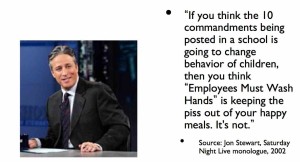Over the past decade lots of folks have been throwing around the term food safety culture to describe how a business operates. Education, training, equipment, tools, the environment, investment and support from higher-ups all influence how well an organization addresses risk, there’s something else that binds it together.
The culture, or value system, can be difference between having an outbreak or not. The values dictate decisions from the front-line staff to the CEO.
Maybe it’s the hippie in me but it’s sort of like the vibe of the organization that can be gauged by asking does anyone really care?

And if they do, do they know what they should be caring about?
The health care world struggles with the same issues, with similar consequences. According to Yahoo News the Vanderbilt University Hospital dealt with a culture change around infection control. And it’s taken six years to turn things around.
Dr. Gerald Hickson had two primary concerns after his wife’s double-knee replacement operation at Vanderbilt University Hospital in July 2008: making sure she received appropriate pain control and getting her moving as quickly as possible to avoid blood clots. But as he sat with her during her recovery, Hickson made a disturbing discovery. Most of the nurses, doctors and other hospital workers filing in and out of the room to care for his wife, who was at risk of contracting an infection after surgery, were not washing their hands.
A compulsive person by nature, Hickson started counting. He found 92 instances when staff members should have soaped up or used antiseptic foam. The total number of times they actually did? 32. Hickson did not want to humiliate anyone, but he was also fiercely committed to protecting his wife. With polite Southern collegiality, he calmly pointed out the 60 opportunities when staffers could have provided safer care but didn’t. Some staffers were immediately embarrassed. Several wondered if he was kidding, got defensive and offered explanations for their lapses.
Hickson reported his findings to Dr. Tom Talbot, VUMC’s chief epidemiologist, and Talbot ran with it, spearheading an ambitious clean hands initiative that was launched in July 2009. Since then, hand-washing rates at Vanderbilt have jumped from 58 percent to 97 percent; at the same time, the number of several stubborn infections has dropped, one of them by as much as 80 percent. “We get into bad habits, all of us do, and sometimes we need somebody to remind us to get back on the right pathway,” says Hickson. “That’s the key to transforming health care.”
Talbot orchestrated a number of practical changes right away, including installing additional hand sanitizer dispensers at the entrance and exit of every patient’s room or bay and within easy reach inside. Staffers were instructed to clean their hands before and after every encounter with patients, even if all they planned to do was have a conversation. Even the smallest details were addressed. Clinicians who complained that their skin had become irritated by excess antiseptic gel were told to cut back to a dime-size portion, and moisturizing lotion dispensers were added throughout the hospital.
That was the easy part. Talbot knew that it would take an all-out culture shift to see dramatic improvement. A prior hand-washing program, which focused largely on education and random surveillance, had done little to boost rates. This time, Talbot drilled down on what he believed would be the keys to success: training, communication and shared accountability up and down the staff hierarchy.
Because the hospital’s top leadership would be the ultimate enforcers, Hickson and Talbot knew they needed buy-in before the program was officially launched. The old days of giving high-performing doctors a pass on unprofessional conduct — “Oh, that’s just Dr. So and So, that’s how he is” — would be over. Every hospital worker, no matter his or her rank, would be held to the same high standards. “We had to have support from leadership, so if we had pushback, we would elevate that up and they wouldn’t blink,” says Talbot. “Instead, they would say, ‘That’s not the kind of behavior we expect here.’”
Competition is a big motivator at Vanderbilt, too. Hand-washing scores for individual units and departments are tallied up from highest to lowest, and results are posted every month in break rooms and other staff areas so that everyone can see how his or her team compares with the one down the hall. “You want to look better than other services when that scorecard comes out,” says Johnson. “You don’t want to be at the bottom. That’s just human nature.”
Today, after more than 200,000 hand-washing observations, Vanderbilt’s overall hand-washing compliance rate has almost doubled. At the same time, three major types of infections linked to the insertion of tubes and catheters have been reduced considerably, according to Talbot. Urinary tract infections related to catheters in intensive care units have dropped by 33 percent; pneumonia linked to ventilators by 61 percent; and bloodstream infections associated with central lines — the tubing that delivers fluids and medications to patients — by 80 percent in ICUs.
Culture change is not about mission statements and core values written on a poster. It’s about fostering feelings within the organization from top-to-bottom that this stuff matters.
 The objectives of this study were to (1) quantify the burden of salmonellosis hospitalizations in the United States, (2) describe hospitalization characteristics among salmonellosis patients with concurrent chronic conditions, and (3) examine the relationships between salmonellosis and comorbidities by four hospital-related outcomes.
The objectives of this study were to (1) quantify the burden of salmonellosis hospitalizations in the United States, (2) describe hospitalization characteristics among salmonellosis patients with concurrent chronic conditions, and (3) examine the relationships between salmonellosis and comorbidities by four hospital-related outcomes.










